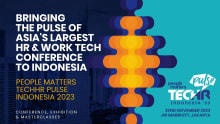Paradigm shift in HR Technology, a key to drive the future of work

Leading the way
These unprecedented times, brought on by the COVID-19 pandemic, are presenting unforeseen challenges for companies. HR has become the nerve centre of their response. From the initial reaction of activating remote working for its entire workforce to strategizing to help employees survive and thrive in the new working conditions, the HR leaders have been at the forefront of formulating crucial policies.
The pandemic has exponentially expanded the role and scope of HR- as employees are collectively experiencing more disruption in their professional and personal lives than ever before. HR is carrying the mantle of being the voice of the company on a daily basis, guiding the leadership and employees to effectively and efficiently adapt to the new normal. HR professionals are literally keeping the companies together while everyone has been forced to be apart. Ensuring connection, empathy and employees’ mental well-being have been top priorities for HR managers during the last few months.
However, despite the slew of daily challenges that the pandemic has brought, it has also given us an opportunity to innovate and implement changes like never before. It is imperative to prioritize and strategize for the future to survive in this challenging environment. The pandemic accelerated digital transformation and adoption in many areas and HR has been no different.
HR is progressively transforming into a more technology-based profession. Investments in HR tech are enabling streamlining of processes which not only reduces administrative burdens but also lowers costs for organizations. Technology-enabled tools that provide real-time metrics are helping decision-makers to spot trends and manage the workforce more effectively. While talent acquisition technology can prepare organizations to better compete for global talent.
It’s now crucial to approach all facets of HR planning- diversity and inclusion, talent management, operations and workforce assessment with a digital-first mindset.
Effective change management and institutionalizing training
Improvise, adapt and overcome has been the overarching message during the pandemic, however for its successful implementation effective change management within the organization is paramount. For this, continuous engagement with employees is crucial so that they feel connected in the new reality. With that in mind and technology in hand, HR has been guiding leaders towards creative solutions on how to better engage, educate and encourage employees remotely.
Ensuring digitally savvy workforce-with managers trained in effective virtual collaboration-is a critical priority for HR now. Workers are placing more value on training and upskilling than ever before as they look to better equip themselves for job prospects in the post-COVID-19 corporate sector. Introducing high quality in-house online training and subscribing employees to other professional learning platforms for acquiring new skills at this time can help institutionalize the culture of continuous blended learning and training within the organization.
To better optimize employee learning programs companies should also look to integrate principles of gamification within them. Gaming characteristics such as goals, challenges, performance affirmation, instant feedback and curiosity help stimulate enjoyment and engagement in what could otherwise be a boring learning experience. And with a digitally native generation joining the existing multi-generation workforce it is imperative to have unique learning tools that can drive noticeable behavioural change in all learners.
Moment to strengthen Diversity and Inclusion
Strengthening diversity and creating an inclusive workplace has been a central focus for most of us, and it’s become even more critical now. Research shows that beyond the cultural impact, benefits of a diverse workforce reflect directly in higher revenues as it encourages innovation. However, hiring and managing a diverse workforce is challenging, wherein lies the opportunity to leverage technology that can enable HR professionals to advance this aim. With the use of innovative software and platforms, recruiters can now remove bias during the hiring process, enabling a diverse workforce to engage and collaborate better.
With an accelerated acceptance of digital tools and remote interactions, COVID-19 has presented us with a unique opportunity to cultivate Diversity and Inclusion (D&I) within teams. Communication gaps among employees based out of different locations and geographies, linguistic, cultural and even socio-economic differences have often been cited as obstacles to a feeling of inclusivity within the organization. HR leaders should cease this moment by introducing initiatives using technology as a facilitator to make significant and long-lasting changes while continuing to drive the mindset changes at the leadership and emerging levels towards more inclusivity and diversity.
With equity and inclusion becoming a core value in a business that all stakeholders seek, companies need to focus on designing and executing D&I programs that meet these objectives in various dimensions.
Talent acquisition is a bedrock for diversity strategy, and adoption of technology can help to accelerate D&I in this area. Software technology is providing recruiters and talent acquisition professionals with solutions for attracting a diverse workforce, reducing unconscious bias in the recruiting process, and facilitating effective candidate selection. Today, many tools such as text evaluation to minimize bias in job postings, outreach tools with recognized networks of diverse candidates are helping overcome the human barriers. AI allows recruiters to remove any identification details from candidates’ applications during the assessment and resume analysis that objectively matches applicants’ skills to job descriptions Furthermore, the interviewing software can assist in identifying any potential bias of the interviewer- through assessing speech and body movements. These tools can facilitate unbiased hiring.
An effective D&I program needs to focus on building awareness, imparting understanding about unconscious bias and diversity training. It should facilitate employees to better accept different points of view – be it gender, race, or ability – and practice behaviours in workplace situations which are reminiscent of a diverse and inclusive work environment. For this, introducing learning and development programs in technology tools such as using chatbots to interrupt bias, learning content about unconscious bias on various team platforms and providing access to personalized development content can go a long way.
As part of a holistic approach to D&I solutions, listening and engagement tools are critical. These can enable organizations to evaluate the sentiment and identify themes within the feedback they are receiving from employees. Based on data from leadership and employee engagement software, managers can now measure their responses on various platforms. This helps them understand and assess the consistency and inclusivity in their communication and create self-awareness that can assist improvement. Access to such real-time evaluation and feedback that can identify anomalies to inclusivity within teams has the potential to bring about an enormous cultural change in the organization.
Tools such as collaborative workplace apps that encourage meaningful conversations at various levels, virtual chat rooms for discussions and online workshops can enable engagement between leaders and employees. Effective use of data to analyze and identify hiring patterns within the company and introducing tech-enabled processes that can remove unconscious bias from the hiring process is critical. These initiatives have the potential to not only drive higher engagement and diversity but effectively enhance financial performance and enable innovation.
Opportunity to revolutionize processes
The changes forced by the COVID-19 pandemic are in many ways redefining the role of HR. It is now playing an increasingly strategic role. In this scenario, it’s imperative to invest in technologies that can lessen the administrative burden on the HR team. Companies should look to streamline redundant and time-consuming tasks such as screening resume, resolving queries, identifying anomalies and payroll management through Artificial Learning (AI) and Machine Learning (ML) tools.
According to Deloitte, Application of Robotic Process Automation (RPA) can have a significant impact on various aspects of HR-operational and strategic. Applications such as chatbots to answer employee queries are already making a notable difference. Adoption of these technologies will not only increase productivity as it will speed up communications but also enable HR to focus on more valuable functions for its people in these trying times.
Transforming future
Leading with empathy while being agile and responsive to employees’ needs-be it mental well- being or financial considerations-has been at the heart of HR strategies during this pandemic. HR has been the guiding force for managements on how to treat employees, carry on the values, culture and mission of the company and lead the way in these unprecedented times. The role of HR might have transformed forever within companies. Managers and employees are listening and adapting; HR leaders should seize this opportunity, leverage technology and affect long-lasting positive changes for their organizations and people.

















